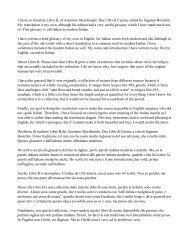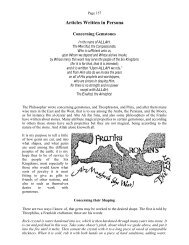How to Milk an Almond Stuff an Egg And Armor a Turnip A ...
How to Milk an Almond Stuff an Egg And Armor a Turnip A ...
How to Milk an Almond Stuff an Egg And Armor a Turnip A ...
You also want an ePaper? Increase the reach of your titles
YUMPU automatically turns print PDFs into web optimized ePapers that Google loves.
141<br />
reintroduction by Sir Fr<strong>an</strong>cis Drake. In 1593 several farmers were engaged <strong>to</strong> grow it in Fr<strong>an</strong>ce,<br />
but in 1630 “the Parliament of Bes<strong>an</strong>çon, from fear of leprosy, forbade the cultivation of the<br />
pota<strong>to</strong>.” In 1619 “Pota<strong>to</strong> figures among the foods <strong>to</strong> be served at the Royal table in Engl<strong>an</strong>d.”<br />
Both sorts of pota<strong>to</strong>es were being grown in parts of Europe before 1600, but it is not clear<br />
whether either was common enough <strong>to</strong> have been served at a feast. If served, pota<strong>to</strong>es would<br />
almost certainly have been regarded as a novelty. I know of no period recipes using pota<strong>to</strong>es.<br />
According <strong>to</strong> Crosby, the sweet pota<strong>to</strong> arrived in China “at least as early as the 1560's.”<br />
Corn<br />
"Corn," in British usage, refers <strong>to</strong> grains in general, most commonly wheat. The earliest<br />
reference in the OED <strong>to</strong> maize, the British name for the grain that Americ<strong>an</strong>s call corn, is from<br />
1555. All of the pre-1600 references are <strong>to</strong> maize as a pl<strong>an</strong>t grown in the New World. Knowledge<br />
of maize seems <strong>to</strong> have spread rapidly; a picture of the pl<strong>an</strong>t appears in a Chinese book on bot<strong>an</strong>y<br />
from 1562. Pictures appear in Europe<strong>an</strong> herbals from 1539 on. Fin<strong>an</strong> concludes that they<br />
represent at least two distinct types of maize, one similar <strong>to</strong> Northern Flints, the other similar <strong>to</strong><br />
some modern Caribbe<strong>an</strong> varieties. Grains are variously described as red, black, brown, blue,<br />
white, yellow <strong>an</strong>d purple.<br />
<strong>How</strong> soon did maize become something more th<strong>an</strong> a curiosity? Leonhard Fuchs, writing in<br />
Germ<strong>an</strong>y in 1542, described it as “now growing in all gardens” [De his<strong>to</strong>ria stirpium–cited in<br />
Fin<strong>an</strong>]. That suggests that in at least one Europe<strong>an</strong> country it was common enough before 1600 so<br />
that it could have been served at a feast–although I know of no evidence that it in fact was, <strong>an</strong>d no<br />
period recipes for it. On the other h<strong>an</strong>d, John Gerard wrote, in 1597: “We have as yet no certaine<br />
proofe or experience concerning the vertues of this kinde of Corne, although the barbarous<br />
Indi<strong>an</strong>s which know no better are constrained <strong>to</strong> make a vertue of necessitie, <strong>an</strong>d think it a good<br />
food: whereas we may easily judge that it nourisheth but little, <strong>an</strong>d is of a hard <strong>an</strong>d euill digestion,<br />
a more convenient food for swine th<strong>an</strong> for m<strong>an</strong>” (Crosby). Gerard’s conclusion is still widely<br />
accepted in Europe. In West Africa, however, maize was under cultivation “at least as early as the<br />
second half of the sixteenth century...” <strong>an</strong>d in China in the sixteenth century (Crosby). There is<br />
also a reference <strong>to</strong> its being grown in the Middle East in the 1570's (Crosby).<br />
Before leaving the subject of maize, I should mention that there have been occasional attempts<br />
<strong>to</strong> argue that it either had <strong>an</strong> Old World origin or spread <strong>to</strong> the Old World prior <strong>to</strong> Columbus.<br />
M<strong>an</strong>gelsdorf discusses the arguments at some length <strong>an</strong>d concludes that they are mistaken.<br />
I know of no evidence that either corn starch or corn syrup was used in period.<br />
Toma<strong>to</strong>es<br />
The first Europe<strong>an</strong> reference <strong>to</strong> the <strong>to</strong>ma<strong>to</strong> is apparently one in a book published in Venice in<br />
1544; it describes the <strong>to</strong>ma<strong>to</strong> as having been brought <strong>to</strong> Italy “in our time” <strong>an</strong>d eaten in Italy<br />
“fried in oil <strong>an</strong>d with salt <strong>an</strong>d pepper.” It appears from later references that <strong>to</strong>ma<strong>to</strong>es were used as<br />
food in both Spain <strong>an</strong>d Italy from the 1500's on. The first printed recipes using <strong>to</strong>ma<strong>to</strong>es appear in<br />
Itali<strong>an</strong> at the end of the 17th century <strong>an</strong>d are described as “alla Spagnuola.” The first use of<br />
“Toma<strong>to</strong>” in English occurs in 1604 in a description of the West Indies (OED). As late as 1753,<br />
<strong>an</strong> English writer describes <strong>to</strong>ma<strong>to</strong>es as “a fruit...eaten either stewed or raw by the Sp<strong>an</strong>iards <strong>an</strong>d<br />
Itali<strong>an</strong>s <strong>an</strong>d by the Jew families in Engl<strong>an</strong>d.” But <strong>an</strong>other writer, at about the same time, asserts<br />
that the <strong>to</strong>ma<strong>to</strong> is “now much used in Engl<strong>an</strong>d,” especially for soups <strong>an</strong>d sauces. (Most of this is<br />
from Longone.)<br />
It appears <strong>to</strong>ma<strong>to</strong>es are out of period for northern Europe <strong>an</strong>d late period for southern Europe,





